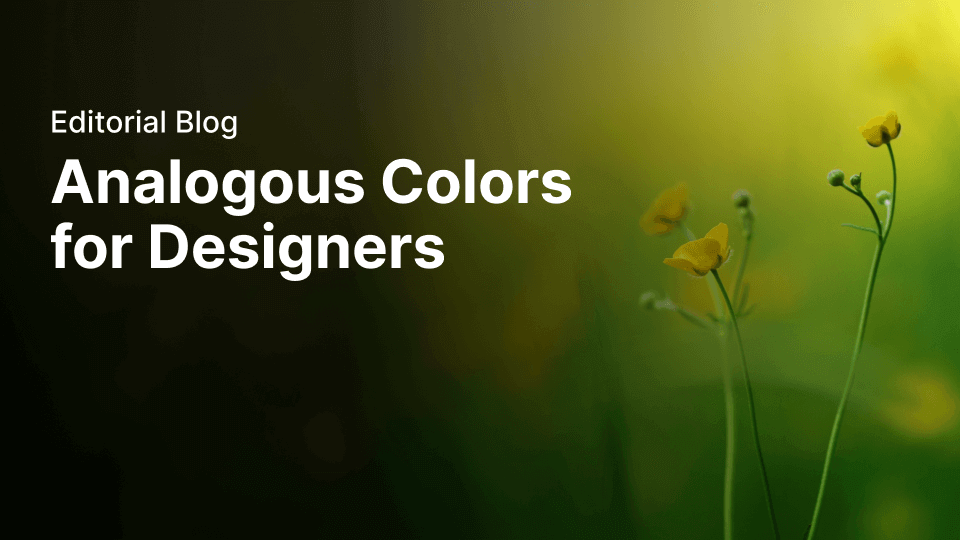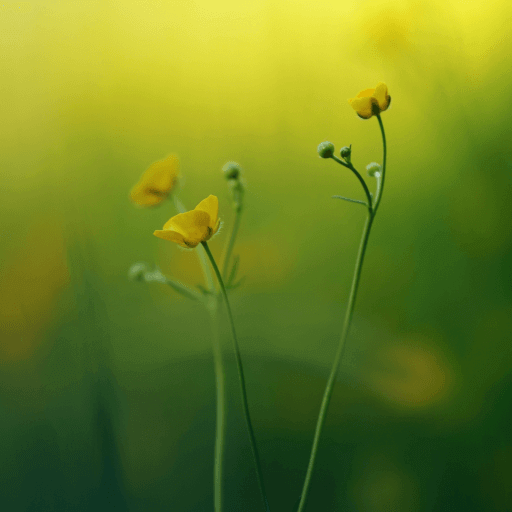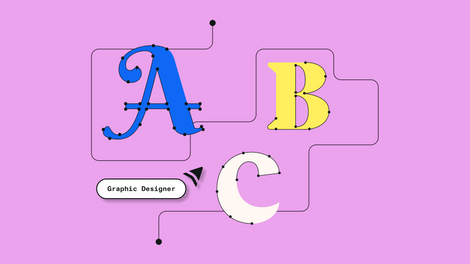What if we told you there was a color scheme that's easy to create and incredibly aesthetically pleasing? Today, we’re talking about analogous colors.
As designers, our lives revolve around colors. Bright colors, clashing colors, and pastel colors.
Knowing the color of the year and the trendiest colors to use in design is essential. But picking the perfect color for your design is hard. We get that. Sometimes, finding a theme to stick to can help that process feel more organic.
Analogous colors can give your designs a look and feel that's natural and subtle while still appearing unique.
This article will cover what analogous colors are, why you should use them, how to use them, and how to create an analogous color scheme in Linearity Curve (formerly Vectornator).
Jumpstart your ideas with Linearity Curve
Take your designs to the next level.
What are analogous colors?
Analogous colors are a group of colors next to each other on the color wheel.
Typically, an analogous color scheme is made up of a base color (often a primary color or secondary color) and a supporting color (often a secondary color or tertiary color).
Then, there is a third color added to the mix that is often a mix of the dominant color and supporting colors. Another option for this third color is an accent color that stands out in the color scheme.
Here is a visual demonstration of some analogous color schemes.
Analogous colors can give your designs a cohesive, monochromatic look. Designers gravitate toward these colors because they are simple and pleasing to the eye. Plus, they’re one of the easiest color schemes to create.
Find a color calling to you from the color wheel and select the colors near it that you want to include in your design.
Examples of analogous color groups
By now, you should know what analogous colors are. But what are some examples of analogous color schemes that you can use in your designs? Here are some examples that you can play around with in your artwork.
- Yellow – Yellow-green, yellow, yellow-orange
- Orange – Yellow-orange, orange, red-orange
- Red – Red-orange, red, red-violet
- Violet – Red-violet, violet, blue-violet
You can use color schemes to create designs that are subtle and easy for viewers to take in.
Analogous color theory
Like many things with design, the basis of analogous color theory all comes down to the color wheel and the colors of the rainbow.
You remember the color wheel, right? Created by everyone’s favorite mathematician and all-around genius, Sir Isaac Newton. For those who don’t, let’s do a quick refresh on color theory.
Using color theory to create designs and selecting the right colors to complement each other is a basic skill every designer needs to know. You've come to the right place if you’re new to design and learning about color theory.
First, the colors of the rainbow:
- Red
- Orange
- Yellow
- Green
- Blue
- Indigo
- Violet
These colors make up the color wheel which also determines complementary colors and is used in color theory.
Using the color wheel, designers can create a complementary color scheme by finding the color across from the color wheel of the color they are using.
These are the three sets of basic complementary colors:
- Yellow and purple
- Blue and orange
- Red and green
Using these color pairs, you can ensure that the colors you use always complement each other. Analogous colors are similar. They are known to work well together, and as a new designer, using color schemes you know will work is an easy way to get started.
Why use analogous colors?
Using an analogous color palette can create a low-contrast design that is easy on the eyes. These designs flow naturally and look immediately cohesive because all the colors go together effortlessly.
Creating a unique color palette isn’t always easy. We created this video to help designers create a unique color scheme.
If you’re creating a color scheme for your design, you should consider analogous colors for a creative but cohesive design. Analogous color schemes look clear and sharp, and there is naturally a lack of tension in the palette.
Using cool colors or warm colors deliberately in your analogous designs can create a uniformity that will help your designs look perfectly curated.
For a warm analogous color scheme, you can use red, orange, yellow, and various hues of these warm colors combined. For a cool analogous color scheme, you can use blue, green, purple, or a mixture of the three.
Ready to create brand assets that pack a punch?
Visit our Academy to learn how to use color palettes.
Still not convinced that you should use analogous colors? Maybe one of the most famous painters of all time can convince you.
Vincent Van Gogh is an artist who knew all about color psychology and color harmonies. He knew how to use the relationship between colors to play on a viewer’s emotions.
Analogous colors are all around us. Often, analogous color schemes occur naturally in the environment.
For example, a sunset features warm analogous colors like pink, yellow, and orange. Succulents are another natural example with their mixture of greens and blues.
How can you use analogous colors in design?
Need examples of how this color scheme can work in your designs? Let’s take a look at some common use cases for this color scheme.
Advertising
In advertising, it's crucial to attract the attention of your target audience in mere seconds. Whether your design is digital or a physical print, you have very little time to attract your audience's attention.
Some companies decide to go with maximalist colors and designs. However, a more minimalistic design with analogous colors can stand out against all of that noise.
Packaging
Packaging design, much like advertising, serves one major function, to attract the attention of your audience. Also, it must be instantly recognizable. If your product is on a physical shelf somewhere, you want to use your brand colors and design to ensure your audience is familiar with your products.
A clean analogous palette using your main branding colors is a great way to do that. Analogous schemes for product designs are simple but impactful.
Logos
Logos are another perfect time to embrace an analogous color scheme. Simply use your main brand color, and create an analogous color scheme based on that color.
Or, go a step further and make your brand colors an analogous color scheme. That way, you can ensure that your branding, website, logos, and all marketing materials are in sync.
Stationery
Stationery is an excellent use of an analogous color scheme. A cohesive and less intrusive design scheme will help when you want important information to be the focus. Using an analogous color scheme is a great way to ensure your text will stand out.
Nowadays, stationery is often used for wedding invitations and menus, but you can always create printed marketing materials like business cards using an analogous scheme.
Fashion
Fashion designers have gravitated towards analogous color schemes. Using a color combination that meshes together naturally ensures that your clothes never clash. You can also use an accent color to allow your outfit to pop.
A splash of color can take your monochrome colors to the next level.
Interior Design
Analogous colors work well for interior design and can create a perfect color scheme for a room. If you want your room to look put together and classy, use a design that immediately clicks.
Using an analogous color scheme will take some of the effort out of designing a room.
Tips for using an analogous color scheme
If you’re ready to embrace analogous color schemes, you will need to know the basic tips and design principles involved. Luckily, we’ve got you covered. Here are our top tips for using analogous color schemes in your designs.
- Don't overdo it: Analogous color schemes are a great tool to use in your designs, but you need to use them well. Don’t overdo it on one hue or color, and ensure that the colors you use balance each other out.
- Play with hues: When it comes to Analogous color design, hues are your best friend. Play around with the hue of each color in your analogous color scheme to see what works best together. Try a dark hue from one color and a light hue from another to create contrast. Or use all light or all dark hues to create a cohesive design. All dark hues may give your design a maximalist look, while lighter hues will appear soft and minimalist.
- Be mindful of your color choices: Picking the right set of analogous colors for your design can make or break the piece's success.
- Use contrast: Using several similar colors can result in your image appearing boring if you don’t go out of your way to create contrast and dimension in your design. You can do this using texture, shapes, and negative space.
Analogous color scheme designs we love
Now that you know exactly what an analogous color is, you’ll need some inspiration to get started. Check out some of our favorite examples of analogous colors used in design.
These examples will show you how other designers use this color scheme successfully.
These cool colors are powerful in this interior design. The different hues of blue and green combined with deep purples and browns create a harmonious design that still holds contrast and is interesting to look at.
This is a seriously cool palette and a modern example of an analogous color scheme. This is the perfect example of how a monochromatic color scheme can be futuristic and bold when done correctly.
The splash of pink, along with the various colors of blue, creates a fun contrast.
Combining warm colors and cool colors are a great way to use analogous colors. The warm and cool blues in this design mesh together perfectly.
Neutral palettes are another great use of analogous colors. Natural color palettes are very in style lately, and we love the use of neutral colors in this analogous color scheme.
This analogous scheme is taking us right to the 70s. Orange, red, and pink are the ultimate color combination for retro analogous designs.
Linearity Curve's (formerly Vectornator) color updates
We’re color-obsessed here at Linearity, and we know that color is your bread and butter as a designer. That’s why we keep updating our software to support more advanced color options.
Ready to create brand assets that pack a punch?
Visit our Academy for free marketing design courses.
The 4.7 update of Linearity Curve (formerly Vectornator) included tons of color upgrades to improve your design color schemes. Check out the video below to learn about the 4.7 update.
Here are some of the color tools that we included with our 4.7 update:
- Multiple color palettes: You’ve always been able to create single color palettes with Linearity Curve (formerly Vectornator). Now, you can create, rename, import, save, and delete multiple palettes in Linearity Curve (formerly Vectornator). Plus, there's no limit to the number of color swatches and gradients you can save inside your palette.
- Import Color Palette Files: With our 4.7 update, we support new .swatches and .ASE file formats. This allows you to import endless color schemes into Linearity Curve (formerly Vectornator) from any device with just a drag and drop.

- Search functionality: We added a new search function, now that you can create multiple color palettes. You can easily search for each palette based on its name. You can also set a Primary Palette by selecting the star icon (on Mac).
- Improved functions to use Linearity Curve (formerly Vectornator) and Procreate together: You can easily import your color palettes from Procreate directly into Linearity Curve (formerly Vectornator). You can also drag and drop them using iPad gestures or Split Screen mode.
- Color Widget Update: Our Color Widget now contains each tab from the Color Panel: Picker, Sliders, Palettes, and Effects. This update makes it easier to change your hues, shades, and tones all in one place.
If you’re ready to start, take your first step today and download the 4.7 Welcome Pack. This welcome package includes some unique palettes custom-made by our team.
You can learn more about Linearity Curve (formerly Vectornator) colors on our Learning Hub. You can also check out the video below on improving your color palettes.
How to use analogous colors in Linearity Curve (formerly Vectornator)
Creating an analogous scheme is easy to do with all of the advanced features we have for color schemes. Follow these simple steps to create your own analogous color scheme.
- Pick a color to start your palette.
- Make multiple copies of your color.
- Change the Hue of each color swatch. Do this until you have 5—10 colors to choose from.
- Pick your favorite colors. To create an analogous color scheme, you will need to select the main color and two adjacent colors.
Now that you’re an analogous color expert, use this skill to design your packaging, graphics, and even logos. And make sure to follow us on social media and tag us in some of your analogous color designs. We could use some more inspiration!
Cover photo image source: Unsplash


Jumpstart your ideas with Linearity Curve
Take your designs to the next level.
Share this!
Ben Barnhart
Ben is a Content Lead for Linearity living in Berlin. His hobbies include board games, cooking, reading, and writing.


:quality(75))
:quality(75))



:quality(75))

:quality(75))
:quality(75))



